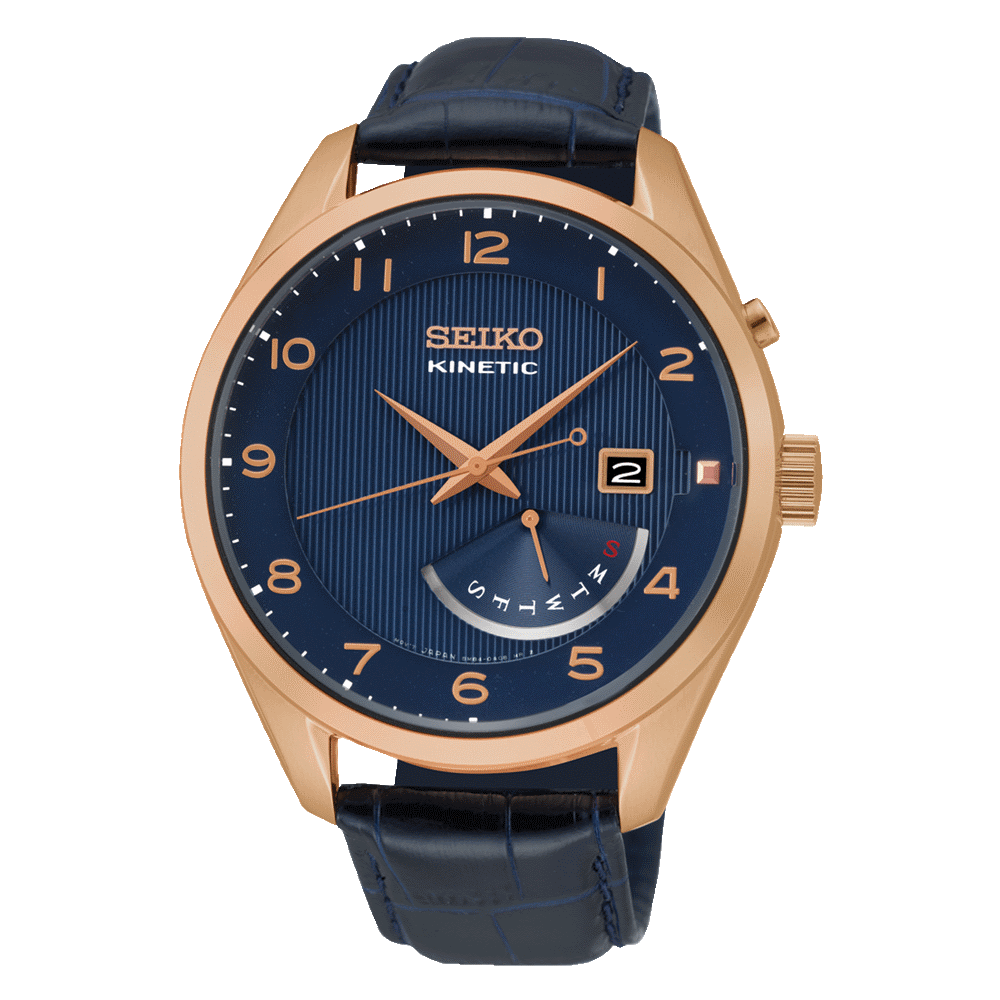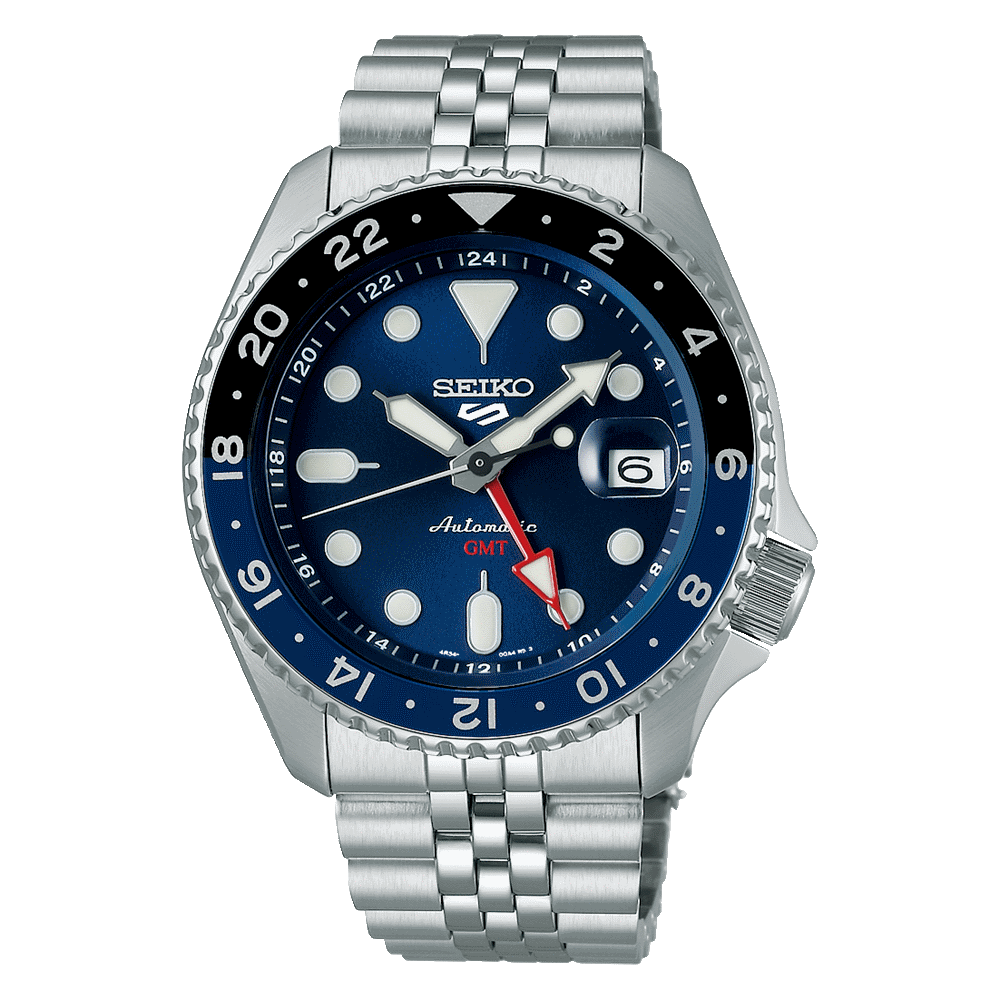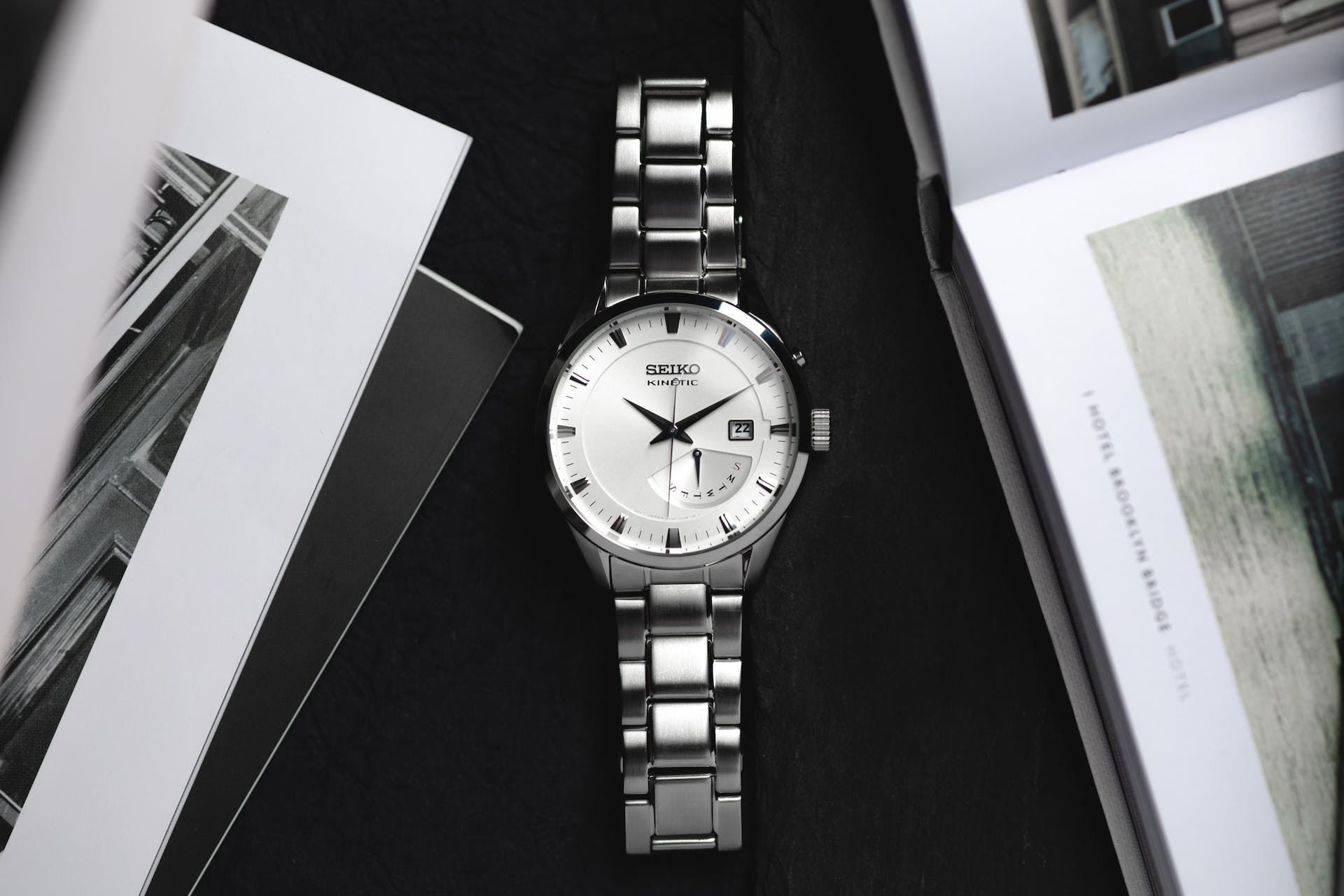Seiko Kinetic watches are known for their innovative blend of mechanical and electronic components. They showcase a fusion of modern technology with traditional watchmaking. As an owner of a Seiko Kinetic watch, I must admit that a timepiece powered by this technology, also known as automatic quartz, motivates you to wear your watch on a daily basis unlike even the best Seiko quartz watches due to the recharge function.
On the other hand, Automatic watches epitomize traditional craftsmanship and mechanical ingenuity. They epitomize the timeless appeal of purely mechanical craftsmanship. When comparing Seiko Kinetic vs Automatic, you must know that each type of watch caters to different preferences, offering enthusiasts a choice between cutting-edge innovation and the enduring charm of traditional mechanical movements.
Popularity of Kinetic and automatic watches
In recent years, there has been a notable resurgence of interest in mechanical watches, fueled by a desire for craftsmanship, uniqueness, and a break from the ubiquitous digital technology that dominates our daily lives. According to RationalStat, The 2022 valuation of the Global Automatic Mechanical Watches Market stood at US$ 48 billion, and it anticipates a substantial Compound Annual Growth Rate (CAGR) exceeding 5.5% during the forecast period from 2023 to 2030, as indicated by the latest market report. Projections suggest that the market will likely reach nearly US$ 73.7 billion by 2030. This growing interest is evident in the renewed appreciation for the intricate engineering and timeless appeal of mechanical timepieces.
At the same time, quartz watches still dominate the global watch market due to their precision, reliability, and cost-effectiveness. The quartz movement, powered by a battery and regulated by a quartz crystal, revolutionized timekeeping, leading to the widespread adoption of quartz watches. Notably, kinetic watches, while distinct in their innovative approach, are rooted in the principles of quartz technology.
“Quartz watch segment is expected to dominate the global automatic mechanical watches market. They have much more aesthetic features which help in driving the market.”
RationalStat LLC
Seiko’s Kinetic watches, for instance, seamlessly integrate the precision of quartz movements with the kinetic energy conversion, offering a unique and eco-friendly alternative within the quartz-dominated landscape. This fusion of traditional and modern technologies continues to captivate enthusiasts seeking a harmonious blend of innovation and reliability in timekeeping. As of 2007, over 8,000,000 Seiko Kinetic watches have been sold since the first commercially available one in 1988.
Seiko Kinetic
Seiko Kinetic watches, while primarily mechanical, often incorporate quartz crystal technology for enhanced timekeeping precision. The quartz crystal is utilized as a regulator to ensure accurate timekeeping. This integration allows Kinetic watches to benefit from the stability and precision of quartz crystals while maintaining their unique kinetic energy conversion mechanism.
Seiko SRN062
- Kinetic Movement
- 10 bar water resistance
- Harlex crystal

In a Kinetic watch, the kinetic movement, powered by the motion of the wearer’s wrist, generates electrical energy. This energy is stored in a rechargeable battery or capacitor. The watch’s internal circuitry, often including a quartz crystal oscillator, ensures accurate timekeeping by regulating the release of stored energy to power the hands and other functions.
In general, Seiko Kinetic is an automatic movement and these watches can be considered as a hybrid between traditional mechanical watches and modern quartz watches. While the primary source of energy in Kinetic watches is kinetic (motion-based), the use of quartz crystal technology complements the mechanical aspect, providing superior accuracy and stability.
Key components
- Rotor. At the heart of the Kinetic mechanism is the rotor, a small, free-moving weight typically shaped like a half-moon. This rotor is connected to the movement of the wearer’s wrist.
- Gear Train. The rotor is linked to a gear train, a series of interconnected gears that transmit the rotational energy from the movement of the rotor to other components of the watch.
- Mechanical Generator. The gear train is designed to drive a miniature mechanical generator. This generator is a crucial component responsible for converting the kinetic energy from the rotor’s movement into electrical energy.
- Capacitor or Rechargeable Battery. The electrical energy generated by the mechanical generator is then stored in a capacitor or a rechargeable battery. This component serves as the power reservoir for the Kinetic watch.
- Circuit Board and IC (Integrated Circuit). The watch’s electronic circuit board, equipped with an integrated circuit (IC), manages the flow of electrical energy. The IC ensures that the generated energy is used efficiently to power the watch’s various functions.
- Quartz Crystal Oscillator. While Kinetic watches are primarily mechanical in nature, they often incorporate a quartz crystal oscillator for enhanced timekeeping precision. The quartz crystal serves as the regulating element, ensuring accurate timekeeping.
- Stepping Motor. A stepping motor is employed to drive the hands of the watch. It receives electrical impulses from the IC, translating the stored energy into the smooth and precise motion of the watch hands.
- Timekeeping Components. The kinetic energy, now converted into electrical power, is utilized to operate the timekeeping functions, including the movement of the hands and, in some models, additional features like date displays or chronograph functions.
Advantages of Seiko Kinetic
Seiko Kinetic watches offer several advantages compared to automatic watches, making them a compelling choice for individuals who value precision, convenience, and sustainability.
Extended power reserve
Seiko Kinetic watches typically have a longer power reserve compared to automatic watches. The rechargeable battery in Kinetic watches can store energy for an extended period, reducing the need for frequent winding or wear to maintain power.
Accuracy
Compared to automatic watches, Seiko Kinetic watches often boast high accuracy due to the integration of quartz crystal technology. The quartz crystal serves as a regulator, ensuring precise timekeeping by providing a stable reference for the watch’s movement.
Low maintenance requirements
Kinetic watches generally have lower maintenance requirements compared to automatic watches. While periodic servicing is recommended, the absence of intricate mechanical components reduces the complexity of maintenance, making Kinetic watches more user-friendly.
Drawbacks of Seiko Kinetic
While Seiko Kinetic watches offer various advantages, they also come with certain disadvantages compared to automatic watches. It’s important to consider these factors when deciding on the type of watch that best suits your preferences and lifestyle.
Battery replacement
Despite their rechargeable nature, Seiko Kinetic watches do require periodic battery replacements. These capacitors typically last from 5 to 15 years while working from 3 to 5 months after a full charge. Understanding the frequency of these changes and associated costs is crucial for potential owners which, in fact, hardly exceeds the cost of automatic movement maintenance or even quartz movement battery replacements.
Dependency on wear
While Kinetic watches have an extended power reserve, they still depend on regular wear to generate kinetic energy. Extended periods of inactivity may lead to a depletion of the stored charge, requiring more effort to restart the watch.
Potential environmental impact
While Kinetic watches eliminate the need for disposable batteries, the environmental impact of manufacturing and disposing of rechargeable batteries should be considered. Proper disposal of these batteries is crucial to mitigate environmental concerns.
Sensitivity to temperature
The performance of Kinetic watches can be affected by extreme temperatures. Very low or high temperatures may impact the efficiency of the kinetic energy conversion and, consequently, the overall functioning of the watch.
Seiko automatic
Seiko automatic movements feature a mainspring, a coiled spring that stores potential energy when wound. This winding process is typically done manually by turning the crown on the side of the watch, or automatically through the motion of the wearer’s wrist.
- Automatic Movement
- GMT Function
- Harlex crystal

The magic of automatic movements lies in the rotor—a semi-circular weight mounted on a pivot. When the watch is worn, the rotor moves with the motion of the wearer’s arm. This movement causes the rotor to pivot, winding the mainspring through a series of gears.
As the mainspring tightens, it stores potential energy. When the wearer is not moving or wearing the watch, the stored energy in the mainspring gradually unwinds and powers the watch’s movement.
The unwinding of the mainspring drives the gears connected to the escapement, which consists of a balance wheel and pallet fork. This regulating mechanism ensures that the energy is released in a controlled manner, causing the gears to oscillate and the hands to move.
The power reserve of Seiko automatic watches varies depending on the specific model and the efficiency of the movement. It defines how long the watch can run without further winding or motion.
Key components
- Mainspring. The mainspring is a coiled spring that stores potential energy when wound. It is a fundamental component that powers the entire watch movement.
- Rotor. The rotor is a semi-circular weight mounted on a pivot. It is connected to the movement of the wearer’s arm and rotates with wrist motion, winding the mainspring.
- Automatic Winding Mechanism. The automatic winding mechanism includes gears and springs that transfer the rotational energy from the rotor to the mainspring. This system allows the watch to self-wind with the motion of the wearer.
- Escapement Mechanism. The escapement consists of a balance wheel and pallet fork. It regulates the release of energy from the mainspring in a controlled manner, ensuring the precise movement of the watch hands.
- Gear Train. The gear train transmits the energy from the escapement to various components of the movement, including the hands that indicate hours, minutes, and seconds.
- Balance Wheel. The balance wheel oscillates back and forth, maintaining a constant rate of motion. It plays a crucial role in the regulation of timekeeping by dividing time into equal segments.
- Pallet Fork. The pallet fork is connected to the balance wheel and controls the release of energy to the gear train. It ensures that the energy from the mainspring is distributed evenly.
- Jewels. Bearings or jewels made of synthetic materials like rubies are used at critical friction points within the movement. Jewels reduce friction, enhancing the durability and longevity of the watch.
Advantages
Elegantly marrying heritage with precision engineering, Seiko automatic watches offer a distinct and captivating experience to watch enthusiasts. As we embark on an exploration of the advantages that grace the wrists of Seiko Automatic wearers, we step into a realm where the heartbeat of tradition resonates, and the intricacies of each tick tell a tale of artistry and dedication.
Engaging user experience
The hands-on engagement with an automatic watch, such as manual winding or wearing it daily, can create a more interactive and personal connection between the wearer and the timepiece
No battery replacements
Unlike Seiko Kinetic watches, automatic watches do not require battery replacements. This can be advantageous for users who prefer not to deal with periodic battery changes.
Disadvantages
Like any watch movement type, automatic watches are not without their considerations.
Power reserve limitations
Disadvantage for Automatic: The power reserve of automatic watches is limited, and if not worn regularly, they may stop. This limitation can be inconvenient for individuals who rotate between multiple watches.
Maintenance requirements
Disadvantage for Automatic: Automatic watches may require more frequent servicing compared to Seiko Kinetic watches. The intricate mechanical components need periodic cleaning, lubrication, and adjustment to ensure optimal performance.
Comparison of Seiko Kinetic vs automatic
The user experience of Seiko Kinetic watches is characterized by convenience, sustainability, and low maintenance. On the other hand, Automatic watches offer a more traditional and engaging experience, appealing to those who value heritage, craftsmanship, and the absence of battery replacements. Ultimately, the choice between Seiko Kinetic and Automatic watches depends on individual preferences and the kind of user experience that resonates with the wearer.
Appreciation for craftsmanship
- The combination of mechanical and electronic elements in Seiko Kinetic watches reflects a modern approach to craftsmanship. Watch enthusiasts appreciate the fusion of traditional watchmaking with cutting-edge technology, showcasing the ingenuity and skill of watchmakers.
- The intricate gears, springs, and delicate balance wheels in Automatic watches embody the epitome of traditional craftsmanship. The meticulous assembly and precision required to create a reliable mechanical movement contribute to the allure of these timepieces.
Uniqueness and exclusivity
- Seiko Kinetic watches stand out for their unique power generation system. The blend of kinetic energy conversion and rechargeable batteries sets them apart from traditional quartz and purely mechanical watches, appealing to individuals seeking innovation and exclusivity.
- Automatic movements, being entirely mechanical, appeal to those who appreciate the rarity and uniqueness of a handcrafted timekeeping device. The limited production of mechanical watches contributes to their exclusivity and individuality.
Connection to heritage
- Seiko Kinetic watches, while incorporating modern technology, maintain a connection to Seiko’s rich horological heritage. The brand’s commitment to innovation while respecting its legacy resonates with collectors who appreciate the continuity of craftsmanship across different eras.
- The intricate design and mechanics of Automatic watches often reflect a brand’s heritage and commitment to traditional watchmaking. Many automatic timepieces carry the legacy of centuries-old craftsmanship, connecting wearers to the history and legacy of watchmaking.
Emotional appeal
- The technology behind Seiko Kinetic watches, generating power through the wearer’s movement, adds a dynamic and engaging element. The awareness that the watch is powered by the wearer’s energy creates a personal connection, enhancing the emotional appeal of the timepiece.
- The rhythmic ticking and sweeping motion of an Automatic watch’s second hand contribute to a captivating and almost meditative experience. The sense of connection with the watch’s mechanical heartbeat fosters a unique emotional bond.
I, personally, like the idea of building a watch collection based on different watch styles and movement types since it’s hard to highlight an absolute winner when comparing Seiko Kinetic vs Automatic. Unlike Kinetic, Seiko automatic watches do not rely on batteries, making them purely mechanical timepieces. The charm of automatic movements lies in their traditional craftsmanship and the engaging connection between the wearer and the watch through manual winding or the motion of the wrist. On the other hand, Seiko Kinetic watches offer a unique experience characterized by convenience, sustainability, and low maintenance. Ultimately, the choice between Seiko Automatic and Kinetic watches depends on individual preferences and the kind of user experience that resonates with the wearer.


Leave a Reply